
 |
 |
||||||||
|
|
Lessons Menu - Lesson 1 - Lesson 2 - Lesson 3 - Lesson 4 - Lesson 5 - Lesson 6 - Lesson 7 - Lesson 8 |
| Lesson Plan 7 - Transportation AUTOMOBILES IN THE SACRAMENTO VALLEY |
download
lesson07.pdf |
|
|
OVERVIEW STUDENT OBJECTIVES CALIFORNIA HISTORY STANDARDS BACKGROUND ARTICLE 7 STUDENT ACTIVITY SHEET 7 AND KEY |
ADDITIONAL ITEMS AVAILABLE IN THIS LESSON PLAN: |
|
DOCUMENTS TO DISCUSS
(view online or print screen) |
||||
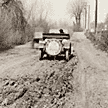 view large image |
1. Two cars on a muddy dirt road [ca. 1910] View of two cars traveling down a rutted and muddy dirt road in the country. |
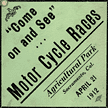 view large image |
2. Scrapbook on
Sacramento bicycling and motorcycling |
|
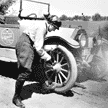 view large image |
3. Cross-country road trip [1916] Amanda Preuss removes a bolt from the rim of her Oldsmobile tire. Part of a cross-country road trip along the Lincoln Highway. |
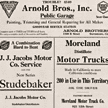 download pdf file |
4. Automobile ads (Your Protection magazine) [1919] Articles and advertisements, including several about the S.S. Albright automobile company. |
|
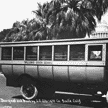 view large image |
5. Willows Union school bus [ca. 1923] Side view of school bus parked in front of palm trees, state capitol building in distance; designed and built by S.S. Albright Co. |
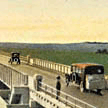 view large image |
6. Causeway over Yolo Basin between Sacramento and Davis, California [ca. 1920] View of the Yolo Causeway with two cars and wagon. |
|
|
INSTRUCTIONS 2. Read Background Article 7. You may wish to read it to your students or have them read it by themselves. Discuss any questions that they may have. 3. Show and discuss Document 1, Photographic print of two cars on a muddy dirt road. Ask students to describe the photo. How old do they think the image is? (ca. 1910) Ask the students to compare the road in the picture to modern roads. Why do they think roads were so bad at that time. 4. The role of the Wheelmen is described in Background Article 7. There are many items in the database related to Document 2, Scrapbook on Sacramento bicycling and motorcycling. These items include a variety of ephemera such as posters and tickets for automobile and motorcycle races sponsored by the Wheelmen and similar groups. Choose several documents to show and discuss. 5. In the early days of automobile travel, there was much interest in racing and in setting cross-country driving records. In 1909, Alice Ramsey became the first woman to complete a coast-to-coast driving trip. Document 3, Cross-country road trip shows Amanda Preuss, a Sacramento woman who traveled cross-country on the Lincoln Highway from San Francisco to New York. An article in the Sacramento Bee (Aug 3, 1916) notes, This young woman will have as her companions two inanimate friends, a .38 caliber revolver and a .22 caliber rifle. She is an expert shot and an expert driver, and is out for a record, which will stand for some time in a cross-continent trip. Successful in her goal, she made the trip in 11 days and 5 hours, beating the previous women's record by 18 hours. To train for the task, Preuss drove from 50 to 100 miles a day, so as to be in physical trim. Upon her return, the Bee reported This was her vacation. She did it for the fun of the thing and to demonstrate that a girl could go it alone across the United States in perfect safety, make good time with ease and certainty. (Aug 21, 1916) Discuss how making such a trip in 1916 would be different from doing so today. 6. Document 4, Automobile ads. Your Protection magazine. This magazine has a variety of articles and images related to the automobile business of S.S. Albright, including a description of his company's factory and manufacturing process. It also notes that a customer could help design customized features for his or her car, which used a Ford body as a base. Download the PDF file and duplicate pages as desired. You may want to have small groups each report on what they learn from an individual page. Also see the collection of Albright images in the SHO database by using the keyword Albright. Why do students think that this company did not last? 7. Document 5, Willows Union school bus. One of the Albright vehicles featured is this school bus. Ask students to compare and contrast it to buses that they see today and to the wagon carrying children, included in Lesson 4. 8. Document 6, Causeway over Yolo Basin between Sacramento and Davis, California. Ask if any students have crossed over this causeway near Sacramento. Ask why the causeway needed to be elevated. To see the engineering feat involved, look in the SHO database for additional images of the Yolo Causeway construction, using the keywords Yolo Causeway. 9. Search the Sacramento History Online database together using the keyword and advanced searches, or let students explore the database independently. What different types of cars and trucks can they discover? How many of the companies represented still exist today? (Ford, Dodge, Oldsmobile, possibly others) 10. Give students Activity Sheet 7: Automobiles (printed from the PDF file). After they have finished the activity, discuss their answers as a group. FOLLOW-UP 2. Find a map that shows the route of the Lincoln Highway. Did it pass through or near your hometown? Read more about how it started. 3. Find the Yolo Causeway on a map. What issues have to be considered today in building a new highway? REFERENCES AND RESOURCES Anderson, M.E. Link across America: A story of the Historic Lincoln Highway. Brown, D. Alice Ramsey's grand adventure. Houghton Mifflin, 1997.
Amanda Preuss [begins cross-country trip]. Sacramento Bee. Amanda Preuss [completes cross-country trip]. Sacramento Bee. Rusch Hyatt, P. Coast to coast with Alice. Carolrhoda Books, 1997. (juvenile) Crabb, R. Birth of a giant: The men and incidents that gave America the motorcar. Hokanson, D. The Lincoln Highway: Main street across
America. Iowa City: Hunt, R. D. and Arent, W.S. Oxcart to airplane. Los Angeles, CA: Powell Publishing Co., 1929. Mason, P. A history of American roads. Chicago: Rand McNally and Company, McConnell, C. A reliable car, and a woman who knows it. McFarland Publishers,
RELATED LINKS The Lincoln Highway Association Lincoln Highway Adventures: Links |
| Sacramento History Online © 2003 - 2004 | |